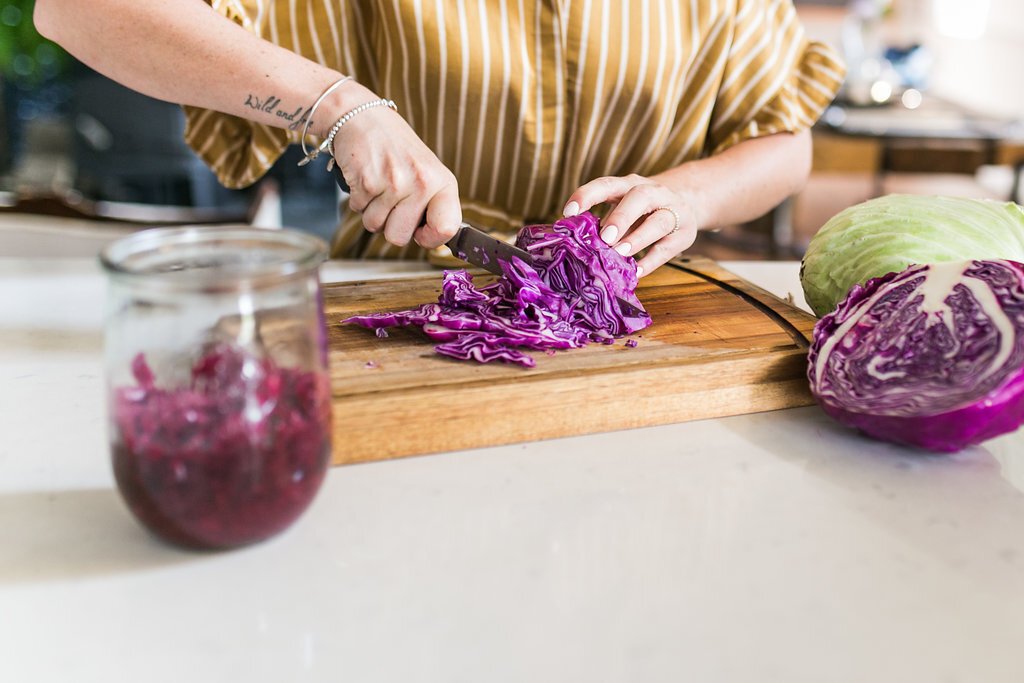How To Make Sauerkraut
Have you ever tried homemade sauerkraut? There is nothing like it, I promise.
It’s homemade from scratch with simple ingredients that support gut health, immunity and mood.
Plus, it’s super easy to master the technique and requires just 3 simple ingredients.
WHAT IS SAUERKRAUT?
Sauerkraut is a fermented food made from cabbage. It has been consumed for thousands of years for its probiotic benefits and it is rich in vitamins C, B, A, K, and a variety of minerals.
It has a tangy flavor, crunchy texture, and is simple and cost-effective to make at home!
The Health Benefits
Certain bacterial strains, which are present to a greater or lesser extent in a serving of fermented
food, have distinct health benefits when tested in isolation. In healthy adults, these bacteria can help improve intestinal flora, prevent acute upper respiratory tract infections, as well as urinary tract infections and allergies, improve immunity and they can lower cardiovascular disease risk .
As well, when it comes to fermented vegetables, the fibre they contain may act as a prebiotic and magnify the effects of the good bacteria, helping them proliferate and produce health-boosting short-chain fatty acids. Some traditional fermented foods have been studied for their unique effects on the body. Studies have also linked fermented food consumption to mental well-being, with outcomes including lower social anxiety and decreased reactions to negative stimuli, although more comprehensive studies are needed to verify these effects in humans.
HOW TO MAKE SAUERKRAUT
My first experience with sauerkraut was when I was working at a sandwich shop in college. The rule was if you showed up late you had to make the “sauerkraut.” It was kind of awful because the sauerkraut was pre-made and came in a giant can, and once you got past the smell, you had to mix it with mayonnaise. Needless to say, it was one of my least favorite tasks and a major motivator to get to work on time.
This sauerkraut, however, is nothing like that. It’s homemade from scratch with simple ingredients to help promote hormone and gut health. Plus, it’s super easy to master the technique and requires just 7 simple ingredients. Shall we?
WHAT IS SAUERKRAUT?
Sauerkraut is a fermented food made from cabbage. It has been consumed for thousands of years for its probiotic benefits and it is rich in vitamins C, B, A, K, and a variety of minerals.
It has a tangy flavor, crunchy texture, and is simple and cost-effective to make at home!
HOW TO MAKE SAUERKRAUT
The simplest form of sauerkraut is just cabbage and salt, which is where we start in this recipe.
Once the salt is added, simply massage with clean hands for 10 minutes or until the cabbage has reduced quite a bit in size and released quite a bit of liquid at the base of the bowl.
Fermented Ginger Purple Sauerkraut
Keeps for 6 months, Makes 2 pint jars
Ingredients
● 6 pounds of red cabbage, shredded
● 1–2″ piece of ginger , peeled and shredded or grated
● 4.5 tbsp sea salt
*3 lbs of cabbage should give you about 2 cups of jarred sauerkraut.
Preparation
1. Dice the cabbage into thin strips with your chef's knife or slice it using your food processor. Peel and grate the ginger.
2. Add all ingredients into a large bowl. Use your hands to scrunch the mixture well for about five minutes. Juice should start to collect at the bottom of the bowl. 3. Once everything has been mixed well, transfer the mixture to a clean glass jar. If the juices do not cover the mixture, add more salted water: 1 tsp of sea salt for 1 cup of water. Make sure there is plenty of room (about 1 1/2 inches) between the contents and the lid so it has room to expand.
4. Add fermentation weight or cabbage leaf.
5. Cover the jar and leave the sauerkraut to ferment for 7-14 days, in a cool, dry spot out of direct sunlight. Fermentation can happen as quickly as 24 hours if your space is hot, or it can take as long as 2 weeks, (again, depending on the environment). We found our sweet spot to be about 10 days.
6. During this fermentation process, open your jars once per day to release air (you should feel pressure release and see air bubbles when you open the jars). Press down with a sterilized object such as a spoon or the bottom of a drinking glass to ensure that the vegetables are still completely covered in the liquid. Doing so helps encourage proper fermentation.
7. The longer it sits and ferments, the tangier it will become, so sample occasionally with a clean utensil to test and see if it is at the right stage for you. Once it has reached the desired tanginess, cover securely and transfer to the fridge, where it should keep at least 3 months and up to 6 months. When serving, don’t double dip to avoid contamination.





